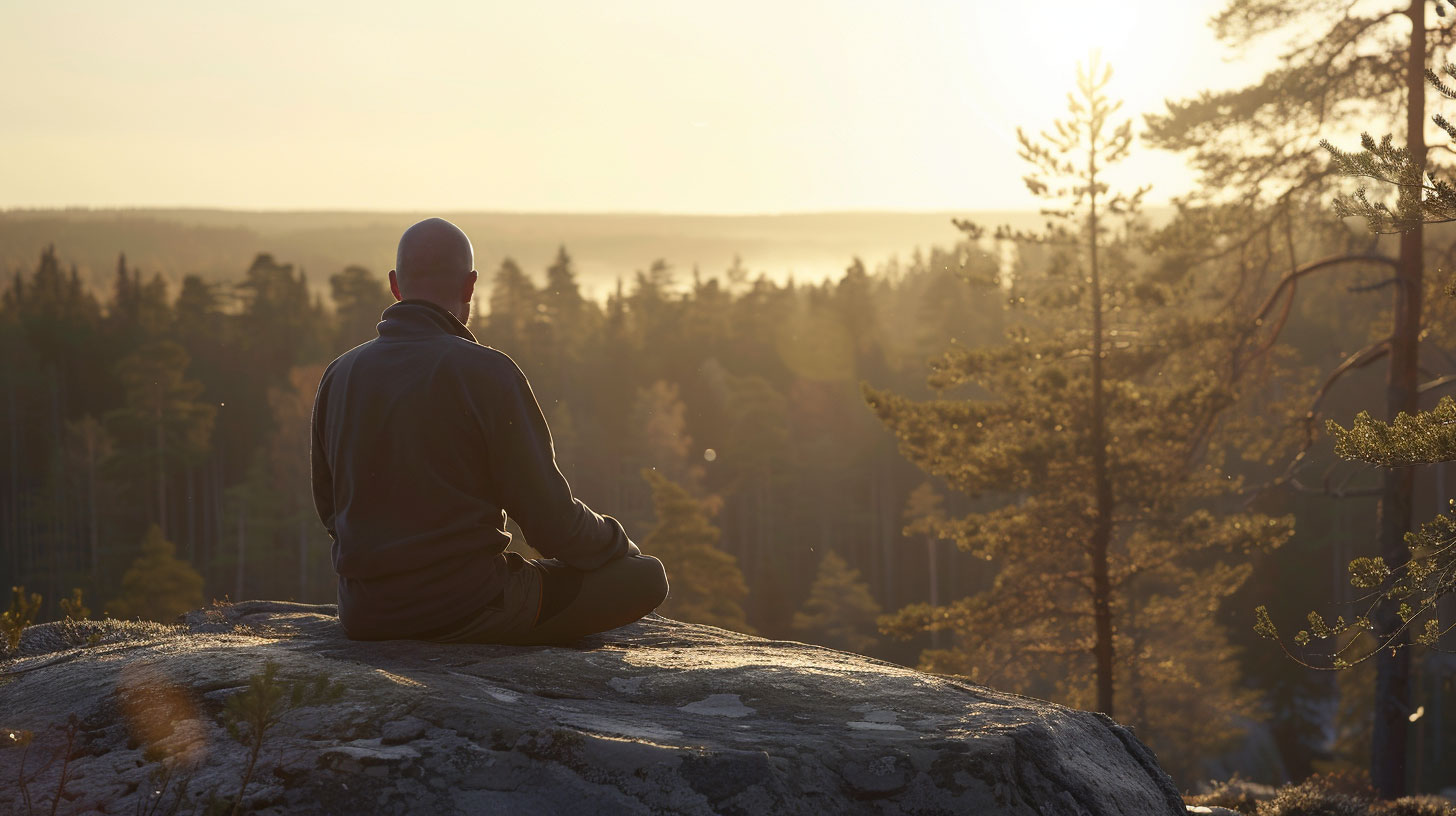Table of contents
The Essence of Forest Bathing
Origins and Principles
In Japan, the practice of shinrin-yoku, known to us as forest bathing, emerged as a pivotal movement in the 1980s. It’s founded on the principle of immersing oneself in the serenity of the woods, engaging in a mindful connection with nature. This practice does not involve the act of swimming or water at all; instead, it’s about basking in the forest atmosphere, allowing the senses to bathe in the natural world around us.
At the core of forest bathing is the idea of presence—being fully aware and awake to the life teeming in the forests. As we wander among the trees, we are encouraged to slow down, breathe deeply, and witness the quiet majesty of nature. This forms an integral part of forest therapy, a guided practice that blends
Health Benefits Unveiled
The benefits of connecting with nature through forest bathing are not just anecdotal; they are backed by scientific research. A notable study led by Stanford University revealed that participants who walked for 90 minutes in a natural area exhibited reduced activity in the brain region associated with a propensity for negative thoughts, which are linked to depression (Mindful).
Furthermore, immersing ourselves in the great outdoors can help recalibrate our internal clock, promoting healthier sleep patterns—vital for our overall wellness. This could mean an activity as simple as camping, allowing the natural light to synchronize our circadian rhythm (Mindful).
Here’s a glance at some of the well-documented benefits of forest bathing for stress relief and other aspects of health:
| Benefit | Description |
|---|---|
| Stress Reduction | Engaging with the forest environment can lead to decreased levels of cortisol, a stress hormone. |
| Mood Improvement | Nature exposure can uplift spirits and help alleviate symptoms of anxiety and depression. |
| Focus and Creativity | Time spent in natural settings can enhance concentration and foster creative thinking. |
| Physical Health | Forest bathing has been linked to lower heart rates and stronger immune system responses. |
These findings underscore the importance of connecting with nature and how practices like forest bathing can significantly influence our psychological and physiological states. By embracing the art of mindfulness in nature, we not only enhance our personal well-being but also cultivate a deeper appreciation and care for the environment, reflecting the profound interconnectedness between our health and the health of our planet. To explore how to integrate these practices into your routine, consider a forest bathing guide or participate in forest bathing exercises to enrich your forest bathing experience.
Crafting Mindfulness in Nature
In the pursuit of wellness, we often overlook the simplest and most profound experiences available to us—those that nature generously provides. By crafting
Engaging Our Senses Outdoors
To fully embrace mindfulness in nature, we must engage all our senses. This immersive practice allows us to experience the textures, aromas, and sounds of the natural world with fresh intensity. It’s not merely about seeing nature, but about letting ourselves be a part of it. By doing so, we foster a non-conceptual awareness that can enhance our emotional well-being, diminish stress, and promote a state of relaxation (Mindfulness Exercises).
When we step into nature, we can practice
- Listening to the rustle of leaves, the flow of water, or the songs of birds.
- Feeling the terrain beneath our feet, the texture of bark, or the caress of the breeze.
- Smelling the earth after rain, the fragrance of flowers, or the crispness of the air.
- Seeing the dance of light through the trees, the vibrant colors, and the intricate patterns in nature.
- Tasting the freshness of the air and perhaps the flavors of edible plants and herbs.
Utilizing all our senses in such a manner allows us to experience a profound and meaningful connection that deepens our
The Art of Mindful Walking
Mindful walking is the art of walking with awareness, where each step taken is an act of connection to the earth and the present moment. As we walk, we focus on the rhythm of our steps, the sensation of movement, and the harmony between our body and the environment. This simple act can lead to improved focus, creativity, and problem-solving abilities, which is especially beneficial for those in demanding work or study environments (TFB Institute).
To practice the art of mindful walking, we can:
- Choose a natural environment for our walk, perhaps a forest path or a beach.
- Begin by standing still, taking a few deep breaths, and acknowledging our intention to walk mindfully.
- Start walking at a natural pace, paying close attention to the feeling of each foot as it touches the ground.
- If our mind wanders, gently guide it back to the sensation of walking and the surrounding natural beauty.
- Continue this practice for a set distance or time, fully immersing ourselves in the experience.
By engaging in mindful walking, we create a moving
Through these practices, we not only cultivate
The Science of Nature’s Impact
In our quest for wellness, we often overlook the profound impact that nature has on our well-being. Recent studies have shed light on the scientific underpinnings of why we feel rejuvenated when we immerse ourselves in the natural world. Let’s delve into the psychological and physiological enhancements that result from
Psychological Improvements
Our mental health flourishes when we step outside and bask in the tranquility of nature. Engaging in forest bathing, a practice rooted in Japanese tradition, can lead to a cascade of mental health benefits. A Stanford-led study has shown that a mere 90-minute walk in a natural setting can significantly reduce repetitive, negative thoughts, a symptom often associated with depression (Mindful).
Moreover, spending time outdoors is linked to uplifted moods and heightened focus. It serves as a creative catalyst, igniting our imaginations and infusing our minds with a burst of ingenuity. The table below outlines some of the key psychological improvements gleaned from studies:
| Benefit | Description |
|---|---|
| Stress Reduction | Engaging with nature eases stress levels. |
| Mood Enhancement | Natural settings boost overall mood. |
| Creativity | Exposure to nature enhances creative thinking. |
| Concentration | Time spent in nature can sharpen focus. |
These improvements underscore the importance of connecting with nature and embracing
Physiological Enhancements
The benefits of nature on our physical health are just as compelling as the psychological ones. Activities such as camping can recalibrate our internal clocks, leading to more restorative sleep patterns. Moreover, exposure to forest environments during activities like forest therapy has been correlated with lower heart rates and stronger immune system responses (Mindful).
Research further suggests that outdoor exercise not only invigorates the body but also promotes a more profound sense of revitalization and higher energy levels compared to working out indoors. The act of
| Physiological Aspect | Improvement |
|---|---|
| Sleep Quality | Nature resets the body’s internal clock. |
| Heart Rate | Reduced heart rate in natural environments. |
| Immune Function | Improved immune response. |
| Energy | Increased vitality from outdoor activities. |
These physiological enhancements serve as a testament to the power of mindfulness in nature and its ability to foster not only personal health but also a deeper environmental connection and care. By integrating these practices into our daily routines, we embark on a path that leads to holistic wellness and a sustained commitment to preserving the beauty of the natural world for future generations.
Mindfulness Techniques Among Trees
As we immerse ourselves in the tranquility of the forest, we can utilize various
Nature Meditation Practices
Meditation is a profound way to engage with the serenity of the natural world. One effective method is nature
Here is a simple guide to begin your nature
- Choose a peaceful area in the forest where you feel comfortable and safe.
- Sit in a relaxed position, close your eyes, and take a few deep breaths to center yourself.
- Open your eyes and observe the natural beauty around you. Notice the light filtering through the leaves, the patterns of the bark, and the movements of wildlife.
- Focus on the sounds of the forest, such as the rustling leaves, the chirping of birds, and the gentle flow of a nearby stream.
- Inhale deeply and savor the scents of the earth, the freshness of the air, and the subtle fragrance of plants.
- Place your hands on the ground or touch the bark of a tree and feel the textures and temperatures.
By engaging in a nature meditation practice, we can achieve deep relaxation and
Sensory Immersion Activities
Sensory immersion activities are designed to fully engage all our senses, allowing us to connect with the present moment and appreciate the beauty and wonder of the natural world (Mindful). Here are some sensory immersion activities that can heighten our mindfulness in nature:
- Visual Exploration: Observe the varying shades of green in the foliage, the shapes and patterns of leaves, and the play of light and shadow.
- Auditory Attention: Close your eyes and identify as many sounds as you can, from the whisper of the wind to the call of a distant bird.
- Tactile Connection: Touch the surfaces around you, like the roughness of tree bark, the smoothness of a pebble, or the softness of moss.
- Olfactory Discovery: Breathe in the different scents of the forest, from the earthy smell of soil to the sweet aroma of flowers.
- Gustatory Experience: If safe to do so, taste the freshness of the air or the clean water from a natural spring.
Engaging in these sensory immersion activities can deepen our experience of
As we practice these techniques among the trees, we not only enhance our personal health but also strengthen our environmental connection and care. Whether we are engaging in forest therapy or simply seeking forest bathing benefits for stress relief, we can find solace and rejuvenation in nature’s embrace.
Integrating Mindfulness into Daily Life
In the serene embrace of the forest, we find a profound depth of peace and rejuvenation. But how can we carry this tranquility into our bustling everyday lives? Let us explore the art of incorporating mindfulness in nature into our daily routines, ensuring that the essence of forest bathing becomes a sustainable practice.
From Forest to Everyday Settings
While we may not always have the privilege of being amidst the trees, we can still foster a connection with nature. We start by creating spaces in our homes and workplaces that echo the tranquility of the forest. This could be as simple as keeping plants in our living areas, using nature-inspired decor, or even listening to recordings of forest sounds.
Our daily commutes and walks can also become opportunities for
Building a Sustainable Practice
To nurture a continuous
Consistency is key to building a sustainable practice. We can use reminders or set alarms to prompt us to pause and connect with the present moment. Keeping a journal of our experiences can also be insightful, helping us reflect on our journey and the personal growth that comes with it.
Moreover, we can extend our practice beyond solitude by engaging in community-based activities that promote connecting with nature, such as group walks or forest therapy sessions. These shared experiences not only deepen our own practice but also foster a sense of unity and collective appreciation for the natural world.
By integrating
The Ripple Effects on Wellness
The practice of immersing ourselves in nature, particularly through
Beyond Personal Health
As we cultivate mindfulness in nature, we are doing more than enhancing our own well-being. We’re fostering a deep connection with the world around us, experiencing a sense of belonging and presence that is often lost in the hustle of day-to-day life. This connection can offer a respite from the overstimulation of modern society, granting us a tranquil harbor in the natural world and leading to improved overall wellness (Mindful).
Our mindful practices in nature can lead us to a greater understanding of the interconnectedness of all beings. This awareness fosters a sense of community and support that transcends our individual experience, linking us to the larger web of life. It’s a reminder that our health is inextricably tied to the health of our surroundings.
Environmental Connection and Care
Engaging in mindfulness in nature also nurtures a profound reverence and awe for the natural world. As we begin to see the beauty and intricacy of nature, we develop a deeper appreciation for its value. This appreciation is the seed from which a strong environmental ethic can grow, compelling us to care for and protect our environment not just for ourselves, but for the well-being of all creatures and future generations (Mindful).
This sense of environmental stewardship is critical in today’s world, where the impacts of climate change and habitat destruction are felt more acutely than ever. By cultivating compassion and care for the earth through practices like forest bathing, we may find ourselves more motivated to take action towards sustainability and conservation. These actions not only contribute to the health of our planet but also reinforce our own sense of purpose and fulfillment.
Ultimately, the practice of
FAQs (Frequently Asked Questions)
Mindfulness in nature can be practiced through engaging all senses to connect with the environment, mindful walking in natural settings, and various nature
Among trees,
Nature’s impact on well-being is profound, offering psychological improvements like stress reduction and mood enhancement, along with physiological enhancements such as better sleep quality, reduced heart rates, and improved immune function.
Forest bathing, or shinrin-yoku, is a Japanese practice from the 1980s focusing on being present in the tranquility of the forest. It involves immersing oneself in nature, using all senses to connect deeply with the surroundings, rather than actual bathing in water.




